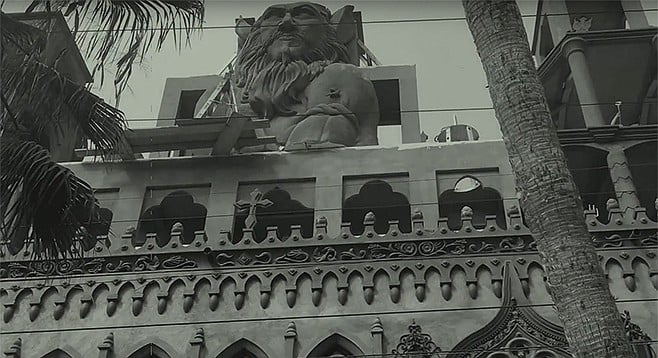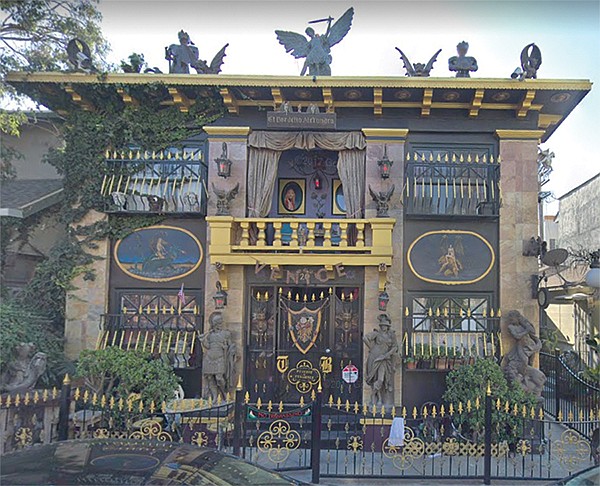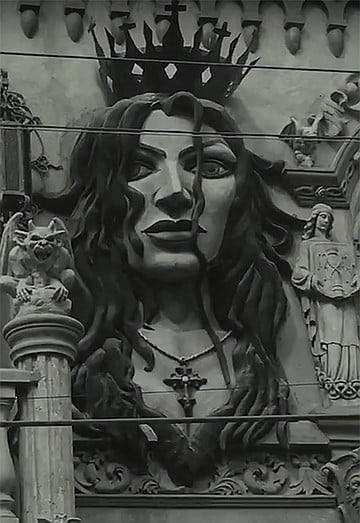 Facebook
Facebook
 X
X
 Instagram
Instagram
 TikTok
TikTok
 Youtube
Youtube


Back in 2011, a real-estate man named Tony Wells caught the attention of the LA Weekly with El Bordello Alexandra, a Venice Beach apartment complex that he’d spent ten years transforming, along with his partner Brittany Stevenson, into the sort of place that’s hard to see for all the decoration. They’d heard it had once been a comfort house (hence the name), and the murals out front harkened to that fleshy past. But the rooftop statuary showed where Wells’ true love lay: classical myth and gothic architecture. Rearing centaurs, crouching gargoyles, Poseidon and St. Michael. Three years later, the LA Times took note, interviewing a resident who called the place “a hallucination materialized. Nothing is really suppressed here.”
That was the warmup. In late October, Frontera.info reported on “the Gothic House on the road between Rosarito and Ensenada.” “I love old churches, you know, in Europe,” Wells told the site, “and I wanted to bring something here to Baja. With the ocean and the mountains, this is the nicest castle I think I’ve ever seen. I want it to be a museum. I want them to film here. I want to share this with everybody. I want to put Baja on the map.”

Nothing is suppressed here, either. Better to say that everything is loosed. A ten-foot relief of Brittany’s face adorns the facade, accompanied by a similar relief of Vlad the Impaler. And above it all rises Wells himself, rendered as Pan. Inside and out is a riot of statues: in concrete, in bronze, in plaster and stone. Multiple copies of Botticelli’s Venus, bored Renaissance angels, Gothic gargoyles, modern unicorns, even E.T. An aesthetic riot.
But it wasn’t until I saw the mermaids at the base of the building — one of them coyly cupping a single breast — that I realized what Wells hath wrought: Baja’s Hearst Castle. It had been 25 years since I’d seen the arching, frolicking mermaids adorning the Neptune Pool in San Simeon’s money-mad mishmash and thought, “Ancient Greece by way of Playboy.” Hearst, too, had a taste for European architecture, and Hearst, too, built a castle that was really a church for his American self.



Back in 2011, a real-estate man named Tony Wells caught the attention of the LA Weekly with El Bordello Alexandra, a Venice Beach apartment complex that he’d spent ten years transforming, along with his partner Brittany Stevenson, into the sort of place that’s hard to see for all the decoration. They’d heard it had once been a comfort house (hence the name), and the murals out front harkened to that fleshy past. But the rooftop statuary showed where Wells’ true love lay: classical myth and gothic architecture. Rearing centaurs, crouching gargoyles, Poseidon and St. Michael. Three years later, the LA Times took note, interviewing a resident who called the place “a hallucination materialized. Nothing is really suppressed here.”
That was the warmup. In late October, Frontera.info reported on “the Gothic House on the road between Rosarito and Ensenada.” “I love old churches, you know, in Europe,” Wells told the site, “and I wanted to bring something here to Baja. With the ocean and the mountains, this is the nicest castle I think I’ve ever seen. I want it to be a museum. I want them to film here. I want to share this with everybody. I want to put Baja on the map.”

Nothing is suppressed here, either. Better to say that everything is loosed. A ten-foot relief of Brittany’s face adorns the facade, accompanied by a similar relief of Vlad the Impaler. And above it all rises Wells himself, rendered as Pan. Inside and out is a riot of statues: in concrete, in bronze, in plaster and stone. Multiple copies of Botticelli’s Venus, bored Renaissance angels, Gothic gargoyles, modern unicorns, even E.T. An aesthetic riot.
But it wasn’t until I saw the mermaids at the base of the building — one of them coyly cupping a single breast — that I realized what Wells hath wrought: Baja’s Hearst Castle. It had been 25 years since I’d seen the arching, frolicking mermaids adorning the Neptune Pool in San Simeon’s money-mad mishmash and thought, “Ancient Greece by way of Playboy.” Hearst, too, had a taste for European architecture, and Hearst, too, built a castle that was really a church for his American self.
Comments